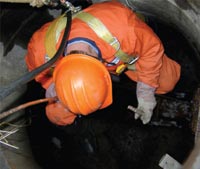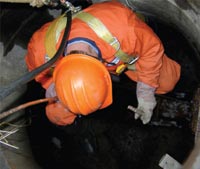
Getting Acquainted with Confined Spaces
Based on vapor density, gases in a confined space will stratify, so obtaining a representative sample at various levels prior to entry is imperative.
- By William Ball
- May 09, 2008
 With somewhere in the neighborhood of 10 million people employed, construction is one of the largest industries in the United States. That’s a lot of people to send home safe every day. Construction work sites present a number of potential safety hazards; employers, with increased awareness, are emphasizing safe work habits to reduce injuries.
With somewhere in the neighborhood of 10 million people employed, construction is one of the largest industries in the United States. That’s a lot of people to send home safe every day. Construction work sites present a number of potential safety hazards; employers, with increased awareness, are emphasizing safe work habits to reduce injuries.
Although it is standard practice that workers are outfitted with all kinds of personal protective equipment (PPE), such as gloves, hard hat, safety glasses, steel-toed boots, safety clothing, fall arrest harness, etc., the safety record in construction is below average. According to U.S. Department of Labor statistics, in 2006 the incidence of work-related injury and illness was 5.9 per 100 full-time construction workers, significantly higher than the 4.4 per 100 workers rate found in the entire private sector.
An often-overlooked article of PPE in the construction industry is the personal safety gas detector. OSHA has been working for years to heighten awareness of the hazards presented by confined spaces that are encountered on construction work sites, and the agency on Nov. 28, 2007, presented a proposed rule draft dealing specifically with confined spaces in construction. Before implementing the proposed rules, OSHA invited input from the construction industry; the deadline for submissions has just passed.
The confined space rules for general industry were introduced in 1993, but these do not apply to construction employers and do not provide the appropriate level of employee protection based on the hazards created by construction activities performed in and around confined spaces. Employees in construction who perform work in confined spaces face a significant risk of death or serious injury, and the proposed rule will substantially reduce this risk. OSHA estimates that in the United States, there are 641,000 entries by construction workers into confined spaces annually, and an average of 6.44 worker fatalities and 967 related injuries occur annually in confined spaces.
Elements of the Proposed Rule
The construction work environment is unique and presents challenges not experienced in other industries. Unlike most general industry work sites, construction worksites are continually evolving. As changes occur, so can the characteristics of confined spaces. It is also common to find multiple contractors and multiple construction disciplines working at a site managed by a single controlling contractor.
Construction generally experiences higher employee turnover rates, and many workers perform short-term tasks at multiple work sites. To address the unique characteristics of the industry, OSHA created 29 CFR Part 1926, Confined Spaces in Construction; Proposed Rule.
The proposed rule requires employers to determine whether a job site has a confined space, identify the existing and potential hazards, and exchange information with all contractors involved in a project. OSHA believes the existing general industry standard for permitrequired confined spaces is not adequate, and the new proposal outlines four different types of confined spaces encountered in construction:
1) A Continuous System-Permit-Require d Confined Space (CS-PRCS) is a confined space that is part of, and contiguous with, a larger confined space (for example, sewers) that the employer cannot isolate from the larger confined space. It is also subject to a potential hazard release from the larger confined space that would overwhelm personal protective equipment and/or hazard controls.
2) A Permit-Required Confined Space (PRCS) is a confined space that has any one of the following: a hazardous atmosphere that ventilation will not reduce to and maintain at a safe level; inwardlyconverging, sloping, or tapering surfaces that could trap or asphyxiate an employee; or an engulfment hazard or other physical hazard.
3) A Controlled-Atmosphere Confined Space (CACS) is a confined space where ventilation alone will control its atmospheric hazards at safe levels. Note also that a confined space cannot be classified as a CACS if it has a physical hazard (unless that hazard has been isolated).
4) An Isolated-Hazard Confined Space (IHCS) is a confined space in which the employer has isolated all physical and atmospheric hazards. “Isolated” means the elimination or removal of a physical or atmospheric hazard by preventing its release into a confined space.
The employer has the option to classify a confined space in any of the four classifications, providing all of the characteristics and requirement for that classification are met. The “Controlling Contractor” is the employer that has overall responsibility for the project. When multiple contractors are employed on work sites, it is the controlling contractor’s responsibility to coordinate entry operations among contractors who have employees in a confined space, regardless whether or not the controlling contractor has employees in the confined space, according to the proposed rule.
Common Confined Space Hazards
In the 1994 study paper “Worker Deaths In Confined Spaces,” NIOSH stated, “Atmospheric conditions such as the presence of toxins, or lack of oxygen, contributed to over half of the confinedspace- related deaths.” Atmospheric hazards are the number one cause of fatalities in confined spaces, although other hazards such as mechanical equipment with moving parts, engulfment, and slips and falls also must be taken into consideration. Unfortunately, most confined space accidents can be attributed to ignorance of the hazard potential.
Because most atmospheric hazards are imperceptible to human senses, it is necessary to assess the confined space atmosphere with an appropriate electronic gas detector. The least favorable conditions should be assumed to exist during every confined space entry. The possibility of explosion, poisoning, and asphyxiation cannot be ignored.
Atmospheric hazards to be aware of are oxygen depletion or enrichment, as well as toxic/poisonous and combustible gases. These conditions may be present prior to entry, or they can arise suddenly at any time during occupation of the confined space. Work being performed in a confined space or activity near confined spaces often can contribute to changes in atmospheric conditions.
Once the atmospheric risks have been assessed, always use an appropriate gas detector to monitor the environment. A basic understanding of the gases that can be encountered and the hazards they present is essential. The majority of confined space entries involve monitoring the atmosphere for oxygen concentration, toxic contaminants, and combustible gases. The most common configuration in a portable gas detector used for routine confined space entry includes oxygen, combustible (% LEL), hydrogen sulfide, and carbon monoxide sensors, but not all applications are the same, and the types of sensors selected should reflect the known and potential atmospheric hazards associated with the confined space. Many detectors available today offer a wide selection of sensor options to provide worker protection. Because confined space entry is the largest single market for portable gas detectors, gas detection manufacturers put huge emphasis toward developing products for this application; there are various options available for consideration when selecting a monitor to suit your needs.
Air Sampling
A key consideration is how to obtain a sample from the confined space atmosphere to determine whether or not it is safe to enter. All gases have a vapor density; in comparison to normal air, some gases are heavier than air, some are lighter, and some have a comparable density. Based on vapor density, gases in a confined space will stratify, so obtaining a representative sample at various levels prior to entry is imperative.
Obtaining a representative air sample from a confined space can be achieved by different methods. The most primitive method still in use is actually lowering a portable detector into the space on a rope, retrieving it, and checking peak readings. But detectors can be physically damaged if they swing against walls, hit ladder rungs, or come into contact with water or mud at the bottom.
Currently, remote sample draw systems are more commonly used for obtaining “pick hole” samples before opening a confined space cover and for sampling the atmosphere at a specific point or level. Two types of remote sample draw systems are generally available: motorized pump and manual hand aspirated squeeze bulb. Manually aspirated squeeze bulbs with attached tubing enable the user to bring the sample to the sensors. This method can be quite arduous, and it can take a large number of squeezes to properly assess the hazard. The motorized pump provides the easiest method for drawing a sample from a remote location. Motorized pumps can be integral or external to the portable safety gas detection instrument.
The sensors in a portable safety gas detector can detect only the gases that actually reach the sensors. For an instrument to accurately determine the concentration of oxygen and other contaminant gases that may be present in a confined space, the sample must first reach the sensors and enough time must be allowed for the sensors to fully stabilize their readings.
Whichever remote sampling technique is employed, always follow the manufacturer’s instructions. Any failure in the sample draw system, such as leakage, pump failure, improper assembly, or absorbance of contaminants in the system being used, can lead to dangerously inaccurate readings. Because most failure modes produce readings that are lower than actual concentration, proper testing of the sample draw system is critical.
Once a confined space has been declared safe and workers enter that space, it is essential to continue monitoring the atmosphere continuously. Ideally, each worker in a confined space should be outfitted with a personal multi-gas detector as part of his everyday PPE. With many gas detection manufacturers devoting a significant portion of their research and development dollars toward the design of smaller, less expensive personal detectors, there are extremely compact and lightweight standard four-gas detectors available. Workers in confined spaces are often encumbered with a lot of PPE, so the smaller the detector, the less likely there will be employee opposition to donning yet another piece of protective equipment. And with lower pricing in the market, it is more affordable for employers to protect employees facing atmospheric gas hazards.
The ideal confined space gas detection package should include an appropriate multi-gas detector with either a built-in or external motorized pump for initial investigation and attendant monitoring, and individual small, lightweight diffusion multi-gas detectors for each employee.
The proposed OSHA standard provides minimum health and safety requirements and procedures to protect employees who work in or near confined spaces. The standard includes requirements for training, hazard analysis, classification, entering, working, exiting, and rescue for confined spaces of various levels. OSHA predicts that when the new rules are properly implemented by construction employers, the average number of fatalities and injuries in confined spaces covered by the proposed rule will be reduced by 90 percent. That means six more workers will stay alive and 880 injuries will be prevented annually.
Most confined space deaths that result from exposure to lethal atmospheric conditions could have been prevented with proper training and the implementation of safe confined space entry procedures. Ignorance and complacency are deadly ingredients when it comes to workplace safety. Be safe, be aware, and don’t become an industrial fatality statistic.
This article originally appeared in the May 2008 issue of Occupational Health & Safety.